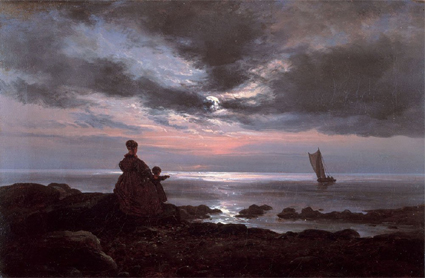In early 1820, a young expatriate Norwegian painter called Johann Christian Dahl was elected a member of the Dresden Academy of Art. Emboldened by his newfound sense of status and financial independence, he proposed marriage to a well-born but impoverished local girl named Emilie von Bloch. The wedding took place on 12 June, and on the following day Dahl set off on a year’s travels through Italy, to experience at first-hand the art of the Old Masters while simultaneously furnishing himself with new themes for his work as a landscape painter. “I want to paint large studies of trees, plants, animals and figures,” he confided to his journal – “to control large masses and to study Tones and Effects, Lighting, Moonlight, etc. etc.”
By early August he had reached Naples, where he stayed at the Villa Quisisana as guest of the crown Prince of Denmark, Christian Frederik. A tradition of open-air oil sketching in the Bay of Naples had been established half a century earlier by the brilliant but obscure Welsh landscape painter, Thomas Jones, and by his French contemporary Pierre-Henri de Valenciennes. They had painted numerous pictures of the crescent-shaped bay, looking out towards the ominous spectacle of Mount Vesuvius, which had frequently been active in the 1770s and 1780s. It came to life once more in 1820. On 20 December, five months after Dahl’s arrival in Italy, it began to erupt. Taking his life in his hands – doubtless to the displeasure of his new bride – the painter ascended the mountain to see the smoke, flames and lava-flows at first hand. Surprised by the intensity of the heat and the overpowering stench of sulphur, he quickly retreated, sketching the volcano from the safety of a beach a few miles away.
The principal result of...


